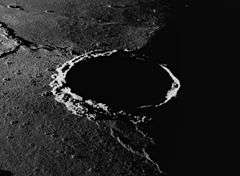Seleucus (crater)
|
Lunar Orbiter 4 image (gray band is artifact of original) | |
| Coordinates | 21°00′N 66°36′W / 21.0°N 66.6°WCoordinates: 21°00′N 66°36′W / 21.0°N 66.6°W |
|---|---|
| Diameter | 61 km |
| Depth | 3.0 km |
| Colongitude | 67° at sunrise |
| Eponym | Seleucus of Seleucia |

Seleucus is a lunar impact crater located in the western part of Oceanus Procellarum. To the west is the lava-flooded remains of the walled plain Eddington. To the southwest is the crater Krafft and to the northwest lies Briggs.
The rim of Seleucus is well-formed, with a terraced inner rim and a slight rampart. The floor is relatively flat, with a small central peak. A bright ray from Glushko crater, about 500 km to the southwest, grazes the southeastern rim of Seleucus.
The narrowness of the rim of Seleucus and the abrupt contact between its raised rim and the surrounding mare prove that the final mare flooding occurred after the crater was formed, and so the crater is older than the youngest (uppermost) mare basalts in the vicinity.[1]
Approximately 50 kilometers to the southeast of Seleucus, on the Oceanus Procellarum, is the landing site of the Soviet landing craft Luna 13.
Satellite craters
By convention these features are identified on lunar maps by placing the letter on the side of the crater midpoint that is closest to Seleucus.
| Seleucus | Latitude | Longitude | Diameter |
|---|---|---|---|
| A | 22.0° N | 60.5° W | 6 km |
| E | 22.4° N | 63.9° W | 4 km |
References
- ↑ Apollo Over the Moon: A View from Orbit (online version) (NASA SP-362), 1978, caption of Figure 31
- Andersson, L. E.; Whitaker, E. A. (1982). NASA Catalogue of Lunar Nomenclature. NASA RP-1097.
- Blue, Jennifer (July 25, 2007). "Gazetteer of Planetary Nomenclature". USGS. Retrieved 2007-08-05.
- Bussey, B.; Spudis, P. (2004). The Clementine Atlas of the Moon. New York: Cambridge University Press. ISBN 978-0-521-81528-4.
- Cocks, Elijah E.; Cocks, Josiah C. (1995). Who's Who on the Moon: A Biographical Dictionary of Lunar Nomenclature. Tudor Publishers. ISBN 978-0-936389-27-1.
- McDowell, Jonathan (July 15, 2007). "Lunar Nomenclature". Jonathan's Space Report. Retrieved 2007-10-24.
- Menzel, D. H.; Minnaert, M.; Levin, B.; Dollfus, A.; Bell, B. (1971). "Report on Lunar Nomenclature by the Working Group of Commission 17 of the IAU". Space Science Reviews. 12 (2): 136–186. Bibcode:1971SSRv...12..136M. doi:10.1007/BF00171763.
- Moore, Patrick (2001). On the Moon. Sterling Publishing Co. ISBN 978-0-304-35469-6.
- Price, Fred W. (1988). The Moon Observer's Handbook. Cambridge University Press. ISBN 978-0-521-33500-3.
- Rükl, Antonín (1990). Atlas of the Moon. Kalmbach Books. ISBN 978-0-913135-17-4.
- Webb, Rev. T. W. (1962). Celestial Objects for Common Telescopes (6th revised ed.). Dover. ISBN 978-0-486-20917-3.
- Whitaker, Ewen A. (1999). Mapping and Naming the Moon. Cambridge University Press. ISBN 978-0-521-62248-6.
- Wlasuk, Peter T. (2000). Observing the Moon. Springer. ISBN 978-1-85233-193-1.
